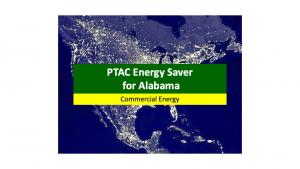- 1 read

TIME TO ACT: Save 20% or more on HVAC. It’s important now more than ever for a sustainable future!
Optimizing PTAC units with a “smart” device is a fast, easy, and cost-effective way to achieve Commercial HVAC Energy Savings. A Packaged Terminal Air Conditioner is a type of self-contained heating and air conditioning system commonly found in: Hotels, Motels, Senior Housing Facilities, Hospitals, Condominiums, Apartment Buildings, and Add-on Rooms & Sunrooms.
Business owners and homeowners face increasing challenges with energy costs to save energy and money in Alabama. PTAC Energy Saver offers an Adaptive Climate Controller (ACC). It is a proven HVAC energy saving device that quickly installs on PTAC units. There are many companies that claim to produce energy savings, but the ACC device is multi-panted and proven over many years. Plus, it has extensive validation tests by organizations such as:
- ConEdison, Manhattan Plaza New York City
- Environmental Test Laboratory, Ohio
- EME Consulting Engineers (Third Party), Sponsored by NYSERDA, New York
- State University of New York, Oneonta, NY
- Tim Garrison (Third Party Testing)
- McQuay Cooling Tests
- Purdue University Tests (Phoenix)
- ConEdison Tests by ERS
Typically, when an HVAC system turns off, shortly after, the blower fan motor turns off. The ACC reprograms the blower fan not to shut off but to throttle back the rpm airflow to an exceptionally low speed, quiescent level airflow or “idle speed”. This allows for a gentle but continuous air movement into the building that helps keep equilibrium of climate conditions in the occupied space and saved energy.
PTAC Energy Saver can help you navigate the complexity of HVAC energy saving choices: CONTACT PTAC Energy Saver
Here is an example of some Commercial HVAC Energy Saving info for Alabama
Alabama Power ranked last in energy efficiency report
As Alabama Power seeks approval for a $1.1 billion expansion of its fleet of power plants, one advocacy group now ranks the utility last in the country for its efforts to promote energy efficiency.
Alabama Power placed last among the country’s 52 largest utilities in the American Council for an Energy-Efficient Economy’s energy efficiency scorecard. Issued last week, the scorecard rates utilities on measured energy reduction, policies and programs offered to help customers reduce their energy usage.
Energy efficiency programs vary from utility to utility but could include things like helping homeowners install better insulation, smart thermostats, or upgrade to more efficient HVAC systems or appliances. They could also include energy audits or financing programs, or policies to promote low energy usage such as avoiding high fixed fees that take away customers’ incentive to save energy.
Many of the programs cited in the report were aimed at helping low-income utility customers or small businesses.
Alabama Power earned just 5 out of 50 possible points on the scorecard, behind Florida Power which scored 6.5 points and Light and Virginia Electric and Power, which scored 7 points. The top performing utilities were Eversource Massachusetts and National Grid Massachusetts, each of which scored 46 points.
Alabama Power spokesman Michael Sznajderman said the scorecard presents an “incomplete and misleading picture” of the company’s efficiency efforts because the scoring system did not take into account all of Alabama Power’s efficiency efforts.
“It puts more emphasis on what utilities spend on energy-efficiency programs rather than results,” Sznajderman said. “Utilities can achieve higher scores by simply spending more money on energy-efficiency programs, regardless of their outcomes.
“Indeed, many utilities that score high in the ACEEE ranking charge prices that are significantly higher than Alabama Power’s.”
The scorecard awarded points to utilities for things including:
- Energy savings through retrofits, smart appliances or other efficiency programs
- Reductions in the utility’s peak demand, when utilities are forced to use the least efficient power plants to meet customers’ needs
- The amount of money spent on efficiency projects
- The percentage of customers who participated in retrofit programs
- Incentives to promote use of electric vehicles, which are more efficient that gas-burning cars and can be charged overnight, during non-peak hours
- Setting specific energy savings targets and making progress towards them

